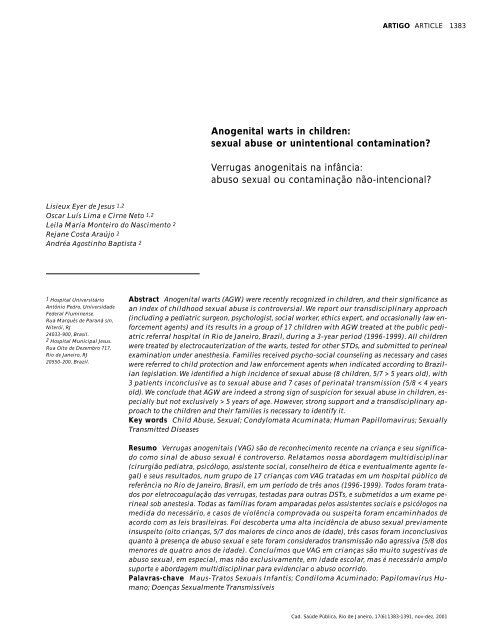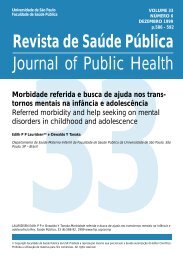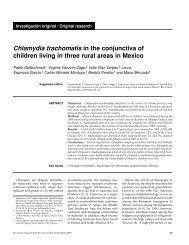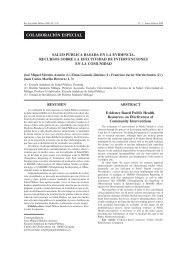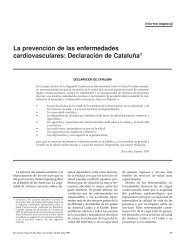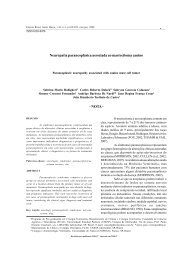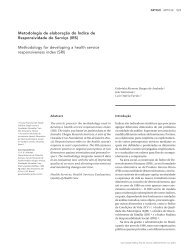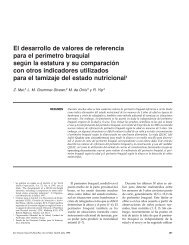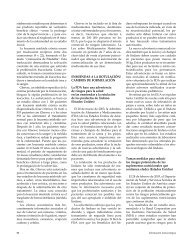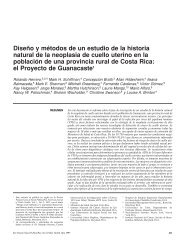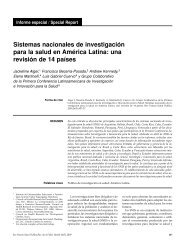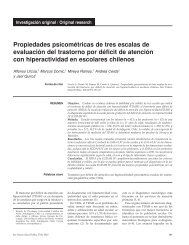Anogenital warts in children: sexual abuse or unintentional ... - SciELO
Anogenital warts in children: sexual abuse or unintentional ... - SciELO
Anogenital warts in children: sexual abuse or unintentional ... - SciELO
Create successful ePaper yourself
Turn your PDF publications into a flip-book with our unique Google optimized e-Paper software.
ARTIGO ARTICLE<br />
1383<br />
<strong>Anogenital</strong> <strong>warts</strong> <strong>in</strong> <strong>children</strong>:<br />
<strong>sexual</strong> <strong>abuse</strong> <strong>or</strong> un<strong>in</strong>tentional contam<strong>in</strong>ation?<br />
Verrugas anogenitais na <strong>in</strong>fância:<br />
abuso <strong>sexual</strong> ou contam<strong>in</strong>ação não-<strong>in</strong>tencional?<br />
Lisieux Eyer de Jesus 1,2<br />
Oscar Luís Lima e Cirne Neto 1,2<br />
Leila Maria Monteiro do Nascimento 2<br />
Rejane Costa Araújo 2<br />
Andréa Agost<strong>in</strong>ho Baptista 2<br />
1 Hospital Universitário<br />
Antônio Pedro, Universidade<br />
Federal Flum<strong>in</strong>ense.<br />
Rua Marquês de Paraná s/n,<br />
Niterói, RJ<br />
24033-900, Brasil.<br />
2 Hospital Municipal Jesus.<br />
Rua Oito de Dezembro 717,<br />
Rio de Janeiro, RJ<br />
20550-200, Brazil.<br />
Abstract <strong>Anogenital</strong> <strong>warts</strong> (AGW) were recently recognized <strong>in</strong> <strong>children</strong>, and their significance as<br />
an <strong>in</strong>dex of childhood <strong>sexual</strong> <strong>abuse</strong> is controversial. We rep<strong>or</strong>t our transdiscipl<strong>in</strong>ary approach<br />
(<strong>in</strong>clud<strong>in</strong>g a pediatric surgeon, psychologist, social w<strong>or</strong>ker, ethics expert, and occasionally law enf<strong>or</strong>cement<br />
agents) and its results <strong>in</strong> a group of 17 <strong>children</strong> with AGW treated at the public pediatric<br />
referral hospital <strong>in</strong> Rio de Janeiro, Brazil, dur<strong>in</strong>g a 3-year period (1996-1999). All <strong>children</strong><br />
were treated by electrocauterization of the <strong>warts</strong>, tested f<strong>or</strong> other STDs, and submitted to per<strong>in</strong>eal<br />
exam<strong>in</strong>ation under anesthesia. Families received psycho-social counsel<strong>in</strong>g as necessary and cases<br />
were referred to child protection and law enf<strong>or</strong>cement agents when <strong>in</strong>dicated acc<strong>or</strong>d<strong>in</strong>g to Brazilian<br />
legislation. We identified a high <strong>in</strong>cidence of <strong>sexual</strong> <strong>abuse</strong> (8 <strong>children</strong>, 5/7 > 5 years old), with<br />
3 patients <strong>in</strong>conclusive as to <strong>sexual</strong> <strong>abuse</strong> and 7 cases of per<strong>in</strong>atal transmission (5/8 < 4 years<br />
old). We conclude that AGW are <strong>in</strong>deed a strong sign of suspicion f<strong>or</strong> <strong>sexual</strong> <strong>abuse</strong> <strong>in</strong> <strong>children</strong>, especially<br />
but not exclusively > 5 years of age. However, strong supp<strong>or</strong>t and a transdiscipl<strong>in</strong>ary approach<br />
to the <strong>children</strong> and their families is necessary to identify it.<br />
Key w<strong>or</strong>ds Child Abuse, Sexual; Condylomata Acum<strong>in</strong>ata; Human Papillomavirus; Sexually<br />
Transmitted Diseases<br />
Resumo Verrugas anogenitais (VAG) são de reconhecimento recente na criança e seu significado<br />
como s<strong>in</strong>al de abuso <strong>sexual</strong> é controverso. Relatamos nossa ab<strong>or</strong>dagem multidiscipl<strong>in</strong>ar<br />
(cirurgião pediatra, psicólogo, assistente social, conselheiro de ética e eventualmente agente legal)<br />
e seus resultados, num grupo de 17 crianças com VAG tratadas em um hospital público de<br />
referência no Rio de Janeiro, Brasil, em um período de três anos (1996-1999). Todos f<strong>or</strong>am tratados<br />
p<strong>or</strong> eletrocoagulação das verrugas, testadas para outras DSTs, e submetidos a um exame per<strong>in</strong>eal<br />
sob anestesia. Todas as famílias f<strong>or</strong>am amparadas pelos assistentes sociais e psicólogos na<br />
medida do necessário, e casos de violência comprovada ou suspeita f<strong>or</strong>am encam<strong>in</strong>hados de<br />
ac<strong>or</strong>do com as leis brasileiras. Foi descoberta uma alta <strong>in</strong>cidência de abuso <strong>sexual</strong> previamente<br />
<strong>in</strong>suspeito (oito crianças, 5/7 dos mai<strong>or</strong>es de c<strong>in</strong>co anos de idade), três casos f<strong>or</strong>am <strong>in</strong>conclusivos<br />
quanto à presença de abuso <strong>sexual</strong> e sete f<strong>or</strong>am considerados transmissão não agressiva (5/8 dos<br />
men<strong>or</strong>es de quatro anos de idade). Concluímos que VAG em crianças são muito sugestivas de<br />
abuso <strong>sexual</strong>, em especial, mas não exclusivamente, em idade escolar, mas é necessário amplo<br />
sup<strong>or</strong>te e ab<strong>or</strong>dagem multidiscipl<strong>in</strong>ar para evidenciar o abuso oc<strong>or</strong>rido.<br />
Palavras-chave Maus-Tratos Sexuais Infantis; Condiloma Acum<strong>in</strong>ado; Papilomavírus Humano;<br />
Doenças Sexualmente Transmissíveis<br />
Cad. Saúde Pública, Rio de Janeiro, 17(6):1383-1391, nov-dez, 2001
1384<br />
JESUS, L. E. et al.<br />
Introduction<br />
The presence of anogenital <strong>warts</strong> (AGW) <strong>in</strong><br />
<strong>children</strong> is a cl<strong>in</strong>ical situation only recently described<br />
<strong>in</strong> medical literature, and medical attitudes<br />
towards it are still a controversial issue,<br />
as their mechanisms of transmission, epidemiology<br />
and future consequences f<strong>or</strong> the patients<br />
are doubtful as yet. There are relatively few articles<br />
dedicated to this issue, especially <strong>in</strong> comparison<br />
to the adult literature, although the<br />
volume of <strong>in</strong>f<strong>or</strong>mation about this theme is<br />
grow<strong>in</strong>g progressively.<br />
One of the difficulties <strong>in</strong> deal<strong>in</strong>g with AGW<br />
<strong>in</strong> <strong>children</strong> is the possibility of <strong>sexual</strong> <strong>abuse</strong> be<strong>in</strong>g<br />
the cause of the problem, and this is the<br />
ma<strong>in</strong> po<strong>in</strong>t of controversy <strong>in</strong> literature, as some<br />
auth<strong>or</strong>s (Cohen et al., 1990; Heaton, 1995;<br />
Obalek et al., 1990) suggest that the disease is<br />
ma<strong>in</strong>ly transmitted by non-<strong>in</strong>tentional transmission<br />
<strong>or</strong> auto <strong>in</strong>oculation <strong>in</strong> childhood.<br />
Those auth<strong>or</strong>s op<strong>in</strong>ions were good news and<br />
were readily and well accepted by pediatricians<br />
and dermatologists, but, unf<strong>or</strong>tunately, they<br />
may represent the truth only <strong>in</strong> a selected age<br />
group, and, even so, after exclud<strong>in</strong>g the possibility<br />
of <strong>sexual</strong> <strong>abuse</strong> beyond reasonable doubt.<br />
As a matter of fact, the exclusion of the hypothesis<br />
of <strong>sexual</strong> <strong>abuse</strong> depends on an entire multidiscipl<strong>in</strong>ary<br />
analysis, on spontaneous rep<strong>or</strong>t<br />
of the fact by the child, physical irrefutable evidence<br />
of <strong>abuse</strong> <strong>or</strong> the presence of someone to<br />
testify over the fact, which can be very difficult,<br />
uncommon, <strong>or</strong> even impossible to obta<strong>in</strong>, especially<br />
<strong>in</strong> preschoolers <strong>or</strong> babies.<br />
We relate here the experience of a pediatric<br />
surgical service with AGW <strong>in</strong> <strong>children</strong> up to 12<br />
years old, emphasiz<strong>in</strong>g that <strong>sexual</strong> aggression<br />
represents the ma<strong>in</strong> route of human papillomavirus<br />
(HPV) contam<strong>in</strong>ation <strong>in</strong> <strong>children</strong> over 5<br />
and a possible cause f<strong>or</strong> the disease <strong>in</strong> younger<br />
ones. The diagnosis of non-<strong>in</strong>tentional contam<strong>in</strong>ation<br />
f<strong>or</strong> the transmission of HPV to <strong>children</strong><br />
rema<strong>in</strong>s to be confirmed after exclud<strong>in</strong>g<br />
<strong>sexual</strong> <strong>abuse</strong>, and we th<strong>in</strong>k that a multidiscipl<strong>in</strong>ary<br />
and careful assessment of each patient is<br />
necessary.<br />
Patients and methods<br />
We relate here a 3-year (Dec 1996-Jul 1999) experience<br />
of a pediatric referral surgical service<br />
<strong>in</strong> the treatment of 17 patients. The cases related<br />
do not represent all cases referred to at our<br />
hospital, but the cases referred by our dermatologists<br />
to one of the auth<strong>or</strong>s (L. E. J.). Criteria<br />
f<strong>or</strong> referr<strong>in</strong>g AGW were no response to topical<br />
treatment <strong>or</strong> spontaneous option of the parents<br />
f<strong>or</strong> surgical treatment (electrocoagulation<br />
of lesions), exclusively. There were no patients<br />
referred because of any suspicion of <strong>sexual</strong><br />
<strong>abuse</strong> and there were no refusals to participate<br />
<strong>in</strong> the study. All the parents were <strong>in</strong>f<strong>or</strong>med that<br />
the possibility of <strong>sexual</strong> <strong>abuse</strong> was to be considered<br />
as a cause of AGW and that the patients<br />
would be <strong>in</strong>vestigated by our multidiscipl<strong>in</strong>ary<br />
team, and they agreed with the protocol.<br />
All of the patients were evaluated by a multidiscipl<strong>in</strong>ary<br />
team consist<strong>in</strong>g of a surgeon (L.<br />
E. J.), a social w<strong>or</strong>ker (L. M. M. N.), and a psychologist.<br />
An ethics expert (O. L. L. C. N.) and<br />
law enf<strong>or</strong>cement agents were consulted as necessary.<br />
All the parents received <strong>in</strong>itially an explanation<br />
concern<strong>in</strong>g the means of transmission<br />
of HPV to <strong>children</strong> and the imp<strong>or</strong>tance of<br />
exclud<strong>in</strong>g unknown <strong>sexual</strong> <strong>abuse</strong> and co-<strong>in</strong>fect<strong>in</strong>g<br />
<strong>sexual</strong>ly transmitted diseases (STD). After<br />
<strong>in</strong>f<strong>or</strong>med consent, the patients were then<br />
<strong>in</strong>cluded <strong>in</strong> a prospective study protocol. This<br />
<strong>in</strong>cluded a careful medical, behavi<strong>or</strong>al and social<br />
hist<strong>or</strong>y collected by the team, a complete<br />
physical exam<strong>in</strong>ation done by the surgeon under<br />
anesthesia, electrocoagulation of the lesions<br />
as treatment and exclusion of associated<br />
STDs. After these <strong>in</strong>itial procedures, the <strong>children</strong><br />
and their families were followed by the<br />
surgeon, the psychologist, and the social w<strong>or</strong>ker<br />
f<strong>or</strong> at least 6 months.<br />
Criteria to consider a case as <strong>sexual</strong> <strong>abuse</strong><br />
f<strong>or</strong> this study were the presence of a second<br />
<strong>sexual</strong>ly transmitted disease, the presence of a<br />
testimony, an irrefutable physical proof of the<br />
episode <strong>or</strong> – most commonly – the rep<strong>or</strong>t of the<br />
episode(s) by the child, spontaneous <strong>or</strong> after a<br />
careful approach by our social w<strong>or</strong>ker <strong>or</strong> psychologist<br />
(Bowen & Aldous, 1999; Paradise,<br />
1990). Cases with serious behavi<strong>or</strong>al problems<br />
detected, not expla<strong>in</strong>ed by other means, with<br />
hist<strong>or</strong>ies suggestive of <strong>abuse</strong> were considered<br />
as probable <strong>abuse</strong> cases.<br />
Results<br />
Ten patients were females and 7 males, ages<br />
ranged from 1 to 9 years f<strong>or</strong> males (mean 5.1<br />
year old – y. o.) and 1 to 8 y.o. f<strong>or</strong> females (mean<br />
3.4 y.o.). Seven patients were < 3 y.o. (table 1).<br />
Extra genital <strong>warts</strong> were looked f<strong>or</strong> <strong>in</strong> all <strong>children</strong>,<br />
and were found <strong>in</strong> only 2 patients (one<br />
<strong>abuse</strong>d, one <strong>in</strong>conclusive). There appeared another<br />
knee common wart <strong>in</strong> a patient, but only<br />
after treatment f<strong>or</strong> AGW. Six of the mothers<br />
were known to be contam<strong>in</strong>ated with HPV and<br />
one mother had regular unprotected <strong>sexual</strong> ac-<br />
Cad. Saúde Pública, Rio de Janeiro, 17(6):1383-1391, nov-dez, 2001
ANOGENITAL WARTS IN CHILDREN<br />
1385<br />
Table 1<br />
General data.<br />
Patient Sex Age (years) Cutaneous <strong>warts</strong> Mother HPV status AGW transmitted by Data<br />
1 F 4 No Unknown Probable <strong>abuse</strong> Child disappeared f<strong>or</strong> 24h, was<br />
found 2 months bef<strong>or</strong>e lesions<br />
appeared, dirty and <strong>in</strong> panic,<br />
<strong>in</strong>capable of relat<strong>in</strong>g what<br />
had happened.<br />
2 F 3 No Unknown Abuse Mother twice denounced f<strong>or</strong> child<br />
<strong>abuse</strong>, not cooperative, admits<br />
<strong>abuse</strong> as probable and refuses to<br />
denounce aggress<strong>or</strong>. Sexually<br />
promiscuous, drug addict, HIV (+).<br />
3 F 2 No AGW Per<strong>in</strong>atal AGW <strong>in</strong> the mother, no hist<strong>or</strong>y<br />
of <strong>abuse</strong>.<br />
4 M 9 Yes, knee Unknown Inconclusive Abuse could not be proved.<br />
Unexpla<strong>in</strong>ed perianal hematoma<br />
and behavi<strong>or</strong>al abn<strong>or</strong>malities.<br />
5 M 8 Yes, after treat<strong>in</strong>g Unknown Probable <strong>abuse</strong> Anomalous behavi<strong>or</strong>. Represents<br />
AGW<br />
persecution by older man <strong>in</strong><br />
psychotherapic sessions.<br />
6 F 3 No AGW Per<strong>in</strong>atal AGW <strong>in</strong> the mother, no hist<strong>or</strong>y<br />
of <strong>abuse</strong>.<br />
7 F 1 No AGW Per<strong>in</strong>atal AGW <strong>in</strong> the mother, no hist<strong>or</strong>y<br />
of <strong>abuse</strong>.<br />
8 M 1 No Negative Inconclusive Abuse not proved. Mother and<br />
Gynecological exam<br />
father tested, not carriers. No<br />
common <strong>warts</strong> <strong>in</strong> child <strong>or</strong> scars.<br />
9 M 8 No Unknown Abuse Abuse by homo<strong>sexual</strong> neighbour,<br />
denounced by child. Child paid to<br />
allow <strong>abuse</strong>. Other <strong>children</strong> also<br />
victims. Aggress<strong>or</strong> arrested.<br />
10 M 6 Yes Unknown Abuse Domestic <strong>abuse</strong> by 16 y.o. cous<strong>in</strong>.<br />
Denounced by child.<br />
11 F 2 No Negative after Probable <strong>abuse</strong> Abn<strong>or</strong>mal behavi<strong>or</strong>, drug addicted<br />
Gynecological exam<br />
parent, no other evidence<br />
of transmission.<br />
12 F 6 No Presumed carrier Abuse Domestic <strong>abuse</strong> by cous<strong>in</strong>.<br />
13 M 2 No Negative after Inconclusive No AGW <strong>in</strong> the mother, no hist<strong>or</strong>y<br />
Gynecological exam<br />
of <strong>abuse</strong>, no other mechanism of<br />
transmission detected.<br />
14 F 5 No AGW Inconclusive AGW <strong>in</strong> the mother (vulvar<br />
condylomata), no hist<strong>or</strong>y of <strong>abuse</strong>,<br />
hist<strong>or</strong>y of shar<strong>in</strong>g towels with<br />
mother.<br />
15 F 7 No Unknown Abuse Abuse by adolescent <strong>in</strong> school,<br />
disclosed by the child. Behavi<strong>or</strong>al<br />
abn<strong>or</strong>malities. Rejection to school.<br />
16 M 2 No AGW, HIV (+) Per<strong>in</strong>atal AGW <strong>in</strong> the mother, no hist<strong>or</strong>y<br />
of <strong>abuse</strong>.<br />
17 F 1 No AGW Per<strong>in</strong>atal AGW <strong>in</strong> the mother, no hist<strong>or</strong>y<br />
of <strong>abuse</strong>.<br />
AGW = anogenital <strong>warts</strong>; HPV = human papillomavirus; HIV = human immunodeficiency virus.<br />
Cad. Saúde Pública, Rio de Janeiro, 17(6):1383-1391, nov-dez, 2001
1386<br />
JESUS, L. E. et al.<br />
tivity with a contam<strong>in</strong>ated man. In 3 of the other<br />
mothers HPV <strong>in</strong>fection was <strong>in</strong>itially excluded<br />
by gynecologic exam<strong>in</strong>ation and Papanicolaou<br />
tests. Seven mothers were not evaluated<br />
f<strong>or</strong> HPV disease by a gynecologic exam<strong>in</strong>ation<br />
(6 mothers of <strong>abuse</strong>d <strong>children</strong>, and the mother<br />
of a 9 y.o. male <strong>in</strong> whom we could not f<strong>in</strong>d the<br />
means of transmission f<strong>or</strong> certa<strong>in</strong>ty, and that<br />
was lost to follow up). In none of these 7 mothers<br />
there was a hist<strong>or</strong>y of <strong>sexual</strong> activity with a<br />
known contam<strong>in</strong>ated partner <strong>or</strong> an abn<strong>or</strong>mal<br />
previous gynecologic exam<strong>in</strong>ation. A father<br />
had a penile condyloma acum<strong>in</strong>atum and 2 fathers<br />
were exam<strong>in</strong>ed by an urologist to exclude<br />
condylomatous lesions. The other 9 fathers<br />
were not medically evaluated, but there were<br />
no signs of disease related by their female partners<br />
(Table 1). All of the mothers and fathers<br />
f<strong>or</strong> whom there was no macroscopic evidence<br />
f<strong>or</strong> HPV disease <strong>or</strong> a related gynecologic <strong>or</strong> urologic<br />
evaluation were counseled to see a doct<strong>or</strong>,<br />
but we could not obta<strong>in</strong> all the results of<br />
their exam<strong>in</strong>ations, as the ones that looked f<strong>or</strong><br />
a doct<strong>or</strong> were seen by other medical services.<br />
Cl<strong>in</strong>ical presentation <strong>in</strong>cluded multiple per<strong>in</strong>eal<br />
<strong>warts</strong> <strong>in</strong> vulva, vag<strong>in</strong>al f<strong>or</strong>nix and hymen<br />
(9/10 girls), perianal lesions (7/10 girls and 6/7<br />
boys) and 2 cases of penile lesions (one of them<br />
extensive per<strong>in</strong>eal lesions <strong>in</strong> a HIV positive<br />
child – case 16). Some patients presented secret<strong>in</strong>g<br />
lesions (13, 14, 16), pruritus (6, 7, 13,<br />
16), bleed<strong>in</strong>g (1, 10, 11, 13, 14, 15, 16), pa<strong>in</strong> (14)<br />
<strong>or</strong> vag<strong>in</strong>al discharge (11, 12). Only one girl had<br />
<strong>in</strong>ternal thigh lesions (2). All <strong>children</strong> were exam<strong>in</strong>ed<br />
under general anesthesia, <strong>in</strong> lithotomy<br />
position. None of the girls had a complete hymen<br />
laceration, but there were 4 cases of partial<br />
rupture and one case of thicken<strong>in</strong>g. In 1<br />
boy, <strong>sexual</strong> <strong>abuse</strong> was evidenced by physical<br />
exam<strong>in</strong>ation under anesthesia (endoanal adult<br />
pubic hair found, case 8), but 1 other had a perianal<br />
hematoma with no hist<strong>or</strong>y of trauma<br />
(case 4). Anal sph<strong>in</strong>cteric tonus was not considered,<br />
as patients were seen under anesthesia.<br />
Regard<strong>in</strong>g physical evidence of <strong>sexual</strong> <strong>abuse</strong>,<br />
there was only one case of a sign with no possible<br />
explanation except <strong>sexual</strong> <strong>abuse</strong> (endoanal<br />
adult pubic hair, case 9), 3 hymeneal lesions<br />
suggestive of <strong>abuse</strong> (cases 2, 12 and 15) and one<br />
perianal hematoma without any known local<br />
trauma (case 4). Per<strong>in</strong>eal exam<strong>in</strong>ations were<br />
n<strong>or</strong>mal <strong>in</strong> 9 patients.(Table 2). Time evolved<br />
between when the lesion was first seen by the<br />
child <strong>or</strong> parent and medical diagnosis varied<br />
between 15 days to m<strong>or</strong>e than a year (mean 3.5<br />
months). Virus typ<strong>in</strong>g was possible only f<strong>or</strong> patient<br />
8 – viral subtypes 6/11 and 16/18 – (Jesus<br />
et al., 1997).<br />
All of the patients were tested f<strong>or</strong> HIV and<br />
syphilis (serological tests), gon<strong>or</strong>rhea and trichomoniasis<br />
(only with gram and wet preparations<br />
of vag<strong>in</strong>al and rectal secretions). We could<br />
not test our patients f<strong>or</strong> Clamidia and we had<br />
no access to gonococcal cultures. Patient 16<br />
was a known symptomatic HIV positive (per<strong>in</strong>atally<br />
transmitted), but patient 2 was newly<br />
diagnosed as HIV (+), asymptomatic as yet.<br />
Two patients were diagnosed and treated f<strong>or</strong><br />
asymptomatic secondary syphilis. We could<br />
f<strong>in</strong>d no cases of gon<strong>or</strong>rhea <strong>or</strong> trichomoniasis <strong>in</strong><br />
our patients.<br />
We could detect 8 cases of <strong>sexual</strong> <strong>abuse</strong><br />
and 5 cases of peripartum transmission (all<br />
preschoolers, cases 3, 6, 7, 16, 17, patient 6 had<br />
2 <strong>in</strong>fected brothers), <strong>in</strong> four patients the mechanism<br />
of transmission f<strong>or</strong> the virus could not<br />
be determ<strong>in</strong>ed. Case 4, a 9 y.o. boy with an unexpla<strong>in</strong>ed<br />
perianal hematoma and behavi<strong>or</strong>al<br />
abn<strong>or</strong>malities was lost to follow up. Cases 8<br />
and 13, both 2 y.o. boys with no hist<strong>or</strong>y of<br />
<strong>abuse</strong> <strong>or</strong> non-hygienic contact, mothers and<br />
fathers exam<strong>in</strong>ed and excluded as carriers f<strong>or</strong><br />
the virus. Case 14, a 5 y.o. girl with no physical<br />
evidences of <strong>abuse</strong> and no hist<strong>or</strong>y <strong>or</strong> circumstantial<br />
evidences of aggression. This patient’s<br />
mother has vulvar condylomatous lesions, but<br />
the girl’s <strong>warts</strong> appeared at 5 y.o. There is a st<strong>or</strong>y<br />
of non-hygienic contact and shar<strong>in</strong>g towels<br />
with the mother (Table 1).<br />
Familiar conditions f<strong>or</strong> the <strong>sexual</strong>ly <strong>abuse</strong>d<br />
<strong>children</strong> were very adverse: 5/8 had < 20 y.o.<br />
mothers, 7/8 of the mothers were div<strong>or</strong>ced from<br />
the child’s father, 3 of them had a new companion,<br />
one of them a third one. One of the mothers<br />
had a st<strong>or</strong>y of <strong>sexual</strong> promiscuity and drug<br />
addition. All <strong>children</strong> (except case 2) lived <strong>in</strong><br />
very promiscuous houses (2 <strong>or</strong> m<strong>or</strong>e families<br />
liv<strong>in</strong>g <strong>in</strong> the same house with <strong>in</strong>sufficient room<br />
f<strong>or</strong> everybody and/<strong>or</strong> a fluctuat<strong>in</strong>g population<br />
of visit<strong>or</strong>s, <strong>in</strong>clud<strong>in</strong>g boy/girlfriends f<strong>or</strong> the<br />
adults cohabit<strong>in</strong>g frequently). Only 3/8 parents<br />
were f<strong>in</strong>ancially responsible f<strong>or</strong> their <strong>children</strong><br />
and just 3/8 fathers were constantly <strong>or</strong> frequently<br />
present. Also 3/8 fathers were completely<br />
absent. There was a hist<strong>or</strong>y of familiar<br />
alcoholism <strong>or</strong> drug addiction <strong>in</strong> 3 cases and<br />
case 10 had a hist<strong>or</strong>y of <strong>abuse</strong> aga<strong>in</strong>st a cous<strong>in</strong>,<br />
witnessed – but not denounced – by the child’s<br />
grandmother. All the <strong>children</strong> <strong>in</strong> the proper age<br />
had serious school problems. Between the non<strong>abuse</strong>d-proven<br />
<strong>children</strong>, there were 2/6 adolescent<br />
mothers (age of the mother <strong>in</strong> case 16 –<br />
dead from HIV <strong>in</strong>fection – is unknown), 3/6 div<strong>or</strong>ced<br />
mothers, but only one new marriage. In<br />
5/6 families the father either cohabited <strong>or</strong> frequently<br />
visited the child and 5/6 parents were<br />
Cad. Saúde Pública, Rio de Janeiro, 17(6):1383-1391, nov-dez, 2001
ANOGENITAL WARTS IN CHILDREN<br />
1387<br />
Table 2<br />
Cl<strong>in</strong>ical signs and symptoms/physical exam<strong>in</strong>ation.<br />
Patient<br />
Description<br />
1 Multiple vulvar, posteri<strong>or</strong> f<strong>or</strong>nix and periclit<strong>or</strong>ial <strong>warts</strong>. Complete hymen, open<strong>in</strong>g diameter 13mm.<br />
2 Multiple vulvar, perianal and <strong>in</strong>ternal thigh <strong>warts</strong>. Hymeneal irregularities. Vulvovag<strong>in</strong>itis. Per<strong>in</strong>eal and external haem<strong>or</strong>rhoidal plexus dilatation.<br />
3 Multiple vulvar, periurethral and perianal <strong>warts</strong>. Hymen not described.<br />
4 Simple perianal wart. Per<strong>in</strong>eal haematoma 10h.<br />
5 Balanic and balanopreputial sulcus multiple <strong>warts</strong>.<br />
6 Multiple vulvar, perianal and hymeneal <strong>warts</strong>. Vulvar and anal pruritus. Complete hymen, open<strong>in</strong>g diameter 19mm.<br />
7 Multiple vulvar and perianal <strong>warts</strong>. N<strong>or</strong>mal hymen.<br />
8 Multiple perianal and endoanal <strong>warts</strong>.<br />
9 Multiple perianal <strong>warts</strong>. Per<strong>in</strong>eal hyperaemia and exc<strong>or</strong>iations. Endoanal ulcer. Endoanal clear secretion and f<strong>or</strong>eign body (adult pubic hair).<br />
10 Multiple perianal and endoanal <strong>warts</strong>. Proctitis. Anal mucosa friable, bleed<strong>in</strong>g and mucoid secretion.<br />
11 Multiple vulvar, hymeneal, periurethral and clit<strong>or</strong>ial <strong>warts</strong>.<br />
12 Multiple <strong>in</strong>ternal thigh, per<strong>in</strong>eal and perianal <strong>warts</strong>. Hymeneal posteri<strong>or</strong> laceration and anteri<strong>or</strong>ly thickened. Open<strong>in</strong>g diameter 5x7mm.<br />
13 Perianal lesions, spontaneous partial regression between first exam<strong>in</strong>ation and electrocoagulation.<br />
14 Hymeneal, perivag<strong>in</strong>al and periurethral lesions. Regular hymen, attenuated.<br />
15 Perianal, perihymenal, periclit<strong>or</strong>ial and endovag<strong>in</strong>al lesions. Hymeneal lesion, hymeneal scar.<br />
16 Per<strong>in</strong>eal, perianal and extensive penile lesions.<br />
17 Perianal unique lesion. N<strong>or</strong>mal hymen.<br />
f<strong>in</strong>ancially responsible f<strong>or</strong> the child (case 16 <strong>or</strong>phan<br />
child).<br />
Behavi<strong>or</strong>al analysis showed that all of the<br />
mothers of victimized <strong>children</strong> cooperated<br />
with <strong>in</strong>vestigations and all of the families accepted<br />
well the <strong>in</strong>vestigative protocol after the<br />
<strong>in</strong>itial explanations about the disease, except<br />
f<strong>or</strong> one (case 2, mother previously denounced<br />
f<strong>or</strong> child neglect and <strong>abuse</strong>). Generically people<br />
were shocked about the possibility of <strong>sexual</strong><br />
<strong>abuse</strong> <strong>in</strong>volv<strong>in</strong>g their <strong>children</strong>, but accepted<br />
it as possible, and wanted to exclude the possibility.<br />
One of the mothers was herself <strong>abuse</strong>d<br />
as a child, and was very anxious about her<br />
daughter (case 1). None of the <strong>children</strong> spontaneously<br />
related the aggression and none of<br />
them related it bef<strong>or</strong>e a strong relationship between<br />
child and medical team was established<br />
as <strong>in</strong>-hospital patients. Of the <strong>abuse</strong>d <strong>children</strong>,<br />
8/8 showed behavi<strong>or</strong>al abn<strong>or</strong>malities: 8/8 <strong>in</strong>trospection<br />
and retraction to contact, 1/8 developmental<br />
regression, 4/8 non-cooperative<br />
behavi<strong>or</strong> towards medical team, 1/8 sadness<br />
and maternal dependency. The mothers said<br />
these signs were “recent”. We had no case of hyper<strong>sexual</strong>ized<br />
behavi<strong>or</strong>. All of the > 5 y.o. <strong>children</strong><br />
were spontaneously better with these<br />
problems after surgery (this was not observed<br />
f<strong>or</strong> the < 5 y.o. patients).<br />
In all cases we used electrocoagulation of<br />
the lesions as the only treatment, <strong>in</strong> 2 sessions<br />
<strong>in</strong> patients 8, 12 and 16 (to treat very extensive<br />
lesions). A very precocious recurrence was<br />
shown <strong>in</strong> patients 2 and 16 (HIV positive). Patient<br />
16 is now hav<strong>in</strong>g a trial with <strong>in</strong>terferon.<br />
No other recurrence was detected <strong>in</strong> the follow<br />
up (m<strong>in</strong>imum 6 months).<br />
Discussion<br />
Despite the persist<strong>in</strong>g controversy about the<br />
mechanisms of contam<strong>in</strong>ation by HPV <strong>in</strong> childhood,<br />
there is a recently established bias to<br />
consider AGW <strong>in</strong> <strong>children</strong> as hav<strong>in</strong>g no evidence<br />
f<strong>or</strong> <strong>sexual</strong> <strong>abuse</strong>, especially among dermatologists<br />
and general pediatricians. This<br />
tendency expla<strong>in</strong>s the non-referral of those patients<br />
f<strong>or</strong> evaluation. This roots <strong>in</strong> various references<br />
<strong>in</strong> pediatric literature deal<strong>in</strong>g with the<br />
possibilities of non-aggressive <strong>in</strong>oculation of<br />
HPV <strong>in</strong> <strong>children</strong> (Allen, 1998; Cohen et al., 1990;<br />
Gutman et al., 1993; Heaton, 1995; Obalek et<br />
al., 1990; Sedlacek et al., 1989; Tseng, 1998) and<br />
to the general rejection of the idea of <strong>sexual</strong><br />
manipulation of <strong>children</strong> (Craighill, 1998),<br />
which <strong>in</strong>tensity is obviously related to the cultural<br />
background of the <strong>in</strong>volved professionals.<br />
As a matter of fact, the specific references cited<br />
to non-aggressive non-per<strong>in</strong>atal <strong>in</strong>oculation<br />
on HPV <strong>in</strong> childhood are few (Bowen & Aldous,<br />
1999; Boyd, 1990; Paradise, 1990). They represent<br />
citations of a small collection of papers,<br />
and the maj<strong>or</strong>ity of the tests are methodologi-<br />
Cad. Saúde Pública, Rio de Janeiro, 17(6):1383-1391, nov-dez, 2001
1388<br />
JESUS, L. E. et al.<br />
cally limited <strong>in</strong> the <strong>in</strong>vestigation of <strong>sexual</strong><br />
<strong>abuse</strong> (e.g. denial of <strong>abuse</strong> because there is no<br />
witness, spontaneous hist<strong>or</strong>y by the victim <strong>or</strong><br />
unquestionable evidence of violence) <strong>or</strong> show<br />
a bias regard<strong>in</strong>g the age of the patients (e.g. papers<br />
with a large maj<strong>or</strong>ity of preschoolers). We<br />
recognize that non- aggressive <strong>in</strong>oculation predom<strong>in</strong>ates<br />
<strong>in</strong> preschoolers, but it was not exclusive<br />
<strong>in</strong> our patients (3 cases of <strong>abuse</strong> <strong>in</strong> this<br />
group of patients) and, perhaps m<strong>or</strong>e imp<strong>or</strong>tant,<br />
all of our <strong>children</strong> > 5 y.o were proved <strong>or</strong><br />
very probable victims of <strong>abuse</strong>, except f<strong>or</strong> 1<br />
case, lost to follow up, <strong>in</strong> which <strong>abuse</strong> could<br />
not be proved, but is strongly suspected (Table<br />
1). These facts, allied to the alarm<strong>in</strong>g numbers<br />
f<strong>or</strong> childhood <strong>sexual</strong> <strong>abuse</strong> cited by various<br />
auth<strong>or</strong>s (Filkelh<strong>or</strong>, 1993) obliges us to always<br />
consider this possibility, especially <strong>in</strong> > 6 y.o<br />
<strong>children</strong>, as this is the maj<strong>or</strong> age group f<strong>or</strong><br />
<strong>abuse</strong> (> 60% of cases) and <strong>in</strong> the case of per<strong>in</strong>atal<br />
transmission, this age group largely surpasses<br />
the time accepted f<strong>or</strong> the latency of the<br />
virus.<br />
In our cases we considered as <strong>sexual</strong> <strong>abuse</strong>s<br />
only cases <strong>in</strong> which there was certa<strong>in</strong>ty (trustful<br />
hist<strong>or</strong>y, witnessed <strong>abuse</strong> <strong>or</strong> medico-legal<br />
proof) <strong>or</strong> strong probabilities of <strong>abuse</strong> (pronounced<br />
behavi<strong>or</strong>al <strong>or</strong> psychological modifications,<br />
unl<strong>in</strong>ked to other facts and analyzed<br />
by our psychologists) (Bowen & Aldous, 1999).<br />
With this criteria, we had evidence of 8/17 cases<br />
of <strong>abuse</strong> (2 < 3 y.o. and 6 > 5 y.o.). There was<br />
physical evidence of penetration <strong>in</strong> only one<br />
child (case 9) and there was no case of rape.<br />
This is <strong>in</strong> agreement with Paradise (1990), who<br />
states, <strong>in</strong>dexes of up to 18% f<strong>or</strong> physical evidence<br />
of <strong>abuse</strong> <strong>in</strong> girls and 17% <strong>in</strong> boys (physical<br />
exam<strong>in</strong>ation under anesthesia). There may<br />
be a bias from our study, as we consider only<br />
<strong>children</strong> referred f<strong>or</strong> non-urgency evaluation<br />
and with no compla<strong>in</strong>ts of trauma <strong>or</strong> spontaneous<br />
hist<strong>or</strong>ies of aggression. In our patients,<br />
the strategies used by aggress<strong>or</strong>s to obta<strong>in</strong> the<br />
child’s cooperation usually <strong>in</strong>volved friendly<br />
talk<strong>in</strong>g <strong>or</strong> play<strong>in</strong>g, emotional menaces and<br />
small prizes.<br />
It is very uncommon to obta<strong>in</strong> evidence of<br />
aggression <strong>in</strong> a first consultation with the child<br />
<strong>or</strong> parents. None of our patients spontaneously<br />
denounced aggressions <strong>in</strong> ambulat<strong>or</strong>y consultations.<br />
All of our disclosures were obta<strong>in</strong>ed after<br />
a relatively long period of time, after hospital<br />
admission and <strong>in</strong>itial treatment and after<br />
build<strong>in</strong>g a strong and trustw<strong>or</strong>thy relationship<br />
with the child and his/her family and health<br />
team. This was very difficult – <strong>or</strong> impossible –<br />
to obta<strong>in</strong> <strong>in</strong> preschoolers. We strongly agree<br />
with Paradise (F<strong>in</strong>kelh<strong>or</strong>, 1993) <strong>in</strong> the fact that<br />
admission <strong>in</strong> a hospital and exam<strong>in</strong>ation under<br />
anesthesia helps a lot <strong>in</strong> the evaluation of these<br />
patients.<br />
Per<strong>in</strong>atal transmission of HPV is def<strong>in</strong>itely<br />
possible, but data is <strong>in</strong>consistent about frequency<br />
and the mechanism of transmission<br />
(transvag<strong>in</strong>al and/<strong>or</strong> other) (Ferenczy, 1995; Ingram<br />
et al., 1992; Moscicki, 1996; Pakarian et<br />
al., 1994), and there is def<strong>in</strong>itive evidence that<br />
a Cesarean section is not protective. It is possible<br />
to detect a 20% presence of DNA from HPV<br />
<strong>in</strong> neonates, but viral DNA disappears <strong>in</strong> a<br />
great prop<strong>or</strong>tion of the babies by 6 weeks of<br />
age, suggest<strong>in</strong>g that contam<strong>in</strong>ation not necessarily<br />
means <strong>in</strong>fection <strong>or</strong> disease (Pakarian et<br />
al., 1994). As admitted maximum <strong>in</strong>cubation<br />
period f<strong>or</strong> AGW transmitted per<strong>in</strong>atally <strong>in</strong> <strong>children</strong><br />
is 2 years (Davis & Emans, 1989; Hammerschlag,<br />
1998; Mosicki, 1996), that mechanism is<br />
a strong consideration only if the disease shows<br />
bef<strong>or</strong>e 3 years old, but it is the<strong>or</strong>etically difficult<br />
to state that it is not possible f<strong>or</strong> the <strong>in</strong>fection<br />
to be present previously – <strong>in</strong> a latent state<br />
– and manifest at later ages as AGW. We th<strong>in</strong>k<br />
that <strong>abuse</strong> must be actively excluded even <strong>in</strong><br />
younger <strong>children</strong>, as we could prove 1 case <strong>in</strong><br />
our group of 9 preschooler patients and 1 case<br />
<strong>in</strong> a 4 y.o. child (Table 1).<br />
Non-aggressive genital <strong>in</strong>fection by HPV<br />
through auto <strong>or</strong> hetero<strong>in</strong>oculation is even m<strong>or</strong>e<br />
controversial. Some auth<strong>or</strong>s admit the possibility<br />
of per<strong>in</strong>eal <strong>in</strong>fection by the hands of <strong>children</strong><br />
<strong>or</strong> adults car<strong>in</strong>g f<strong>or</strong> the child and by<br />
fomites. This is def<strong>in</strong>itely possible, but its frequency<br />
and epidemiological imp<strong>or</strong>tance are<br />
extremely questionable, at best. Cohen et al.<br />
(1990) and Obalek et al. (1990) suggest this possibility<br />
<strong>in</strong> a group of predom<strong>in</strong>antly preschoolers<br />
and toddlers (77% of cases – Cohen et al.,<br />
1990), with an abn<strong>or</strong>mally high <strong>in</strong>cidence of<br />
maternal AGW (16% – Cohen et al., 1990; >50%<br />
– Obalek et al., 1990). In both cl<strong>in</strong>ical studies<br />
the auth<strong>or</strong>s did not detail the mechanisms<br />
used to exclude <strong>abuse</strong>, confirmed <strong>abuse</strong> only if<br />
there is a spontaneously obta<strong>in</strong>ed hist<strong>or</strong>y <strong>or</strong><br />
witness of <strong>abuse</strong> <strong>or</strong> <strong>in</strong>cluded a maj<strong>or</strong>ity of cases<br />
<strong>in</strong> which evidence f<strong>or</strong> <strong>abuse</strong> was “<strong>in</strong>conclusive”.<br />
Despite their belief <strong>in</strong> predom<strong>in</strong>ant nonaggressive<br />
transmission <strong>in</strong> preschoolers both<br />
auth<strong>or</strong>s agree that it is essential to exclude<br />
<strong>abuse</strong> even <strong>in</strong> this age group. Ingram et al.<br />
(1992), <strong>in</strong> a 1,538 childhood STD cases study<br />
documents 1,8% of AGW, and demonstrates<br />
non-aggressive transmission <strong>in</strong> 100% of < 1 y.o.,<br />
71% of 1-2 y.o., 50% of 4-7 y.o. and zero <strong>in</strong> > 6<br />
y.o. We th<strong>in</strong>k that non-abusive, non-per<strong>in</strong>atal<br />
transmission of HPV <strong>in</strong> <strong>children</strong>, although possible,<br />
is conjectural, and is an exclusion diag-<br />
Cad. Saúde Pública, Rio de Janeiro, 17(6):1383-1391, nov-dez, 2001
ANOGENITAL WARTS IN CHILDREN<br />
1389<br />
nosis, very uncommon – if at all present – <strong>in</strong> ><br />
6 y.o. <strong>children</strong>.<br />
Behavi<strong>or</strong>al abn<strong>or</strong>malities were constant<br />
among our <strong>abuse</strong>d patients, and confirm other<br />
auth<strong>or</strong>s beliefs (Swanston et al., 1997). We<br />
must admit that social and familiar adverse<br />
conditions of our group of patients might expla<strong>in</strong><br />
some of the problems verified, but behavi<strong>or</strong>al<br />
problems were present <strong>in</strong> only a m<strong>in</strong><strong>or</strong>ity<br />
of other patients evaluated f<strong>or</strong> non-aggressive<br />
l<strong>in</strong>ked diseases <strong>in</strong> our hospital, from<br />
age matched and social background matched<br />
groups. It was <strong>in</strong>terest<strong>in</strong>g to verify a “n<strong>or</strong>malization”<br />
of behavi<strong>or</strong>al pattern <strong>in</strong> <strong>children</strong> after<br />
successful treatment of the <strong>warts</strong>. We could<br />
f<strong>in</strong>d no reference to this <strong>in</strong> literature, and we<br />
do not know its reasons. Perhaps we could attribute<br />
this to the background given to the<br />
child by our team, but our psychiatrist the<strong>or</strong>izes<br />
that the absence of macroscopic lesions<br />
as a constant evidence of the <strong>abuse</strong> has a role<br />
<strong>in</strong> behavi<strong>or</strong>al modifications after treatment.<br />
F<strong>or</strong> now we are not able to evaluate long term<br />
consequences of the aggression <strong>or</strong> its treatment<br />
<strong>in</strong> our patients, because of the relatively<br />
small follow up period, along with low self-esteem,<br />
depression, high <strong>in</strong>cidence of suicide,<br />
crim<strong>in</strong>ality and adolescent pregnancy are<br />
known sequels of <strong>sexual</strong> aggression <strong>in</strong> childhood<br />
(Swanston et al., 1997).<br />
Investigat<strong>in</strong>g <strong>or</strong> not study<strong>in</strong>g other STD <strong>in</strong><br />
those patients is controversial. By our protocol,<br />
we <strong>in</strong>vestigated syphilis and AIDS (serologic<br />
test<strong>in</strong>g) <strong>in</strong> all patients, by a double dosage (ambulat<strong>or</strong>y<br />
evaluation and dur<strong>in</strong>g hospital admission).<br />
We also collected a vag<strong>in</strong>al smear f<strong>or</strong><br />
gonococcus research. Unf<strong>or</strong>tunately our resources<br />
do not allow us to provide cultures f<strong>or</strong><br />
Neisseria Gon<strong>or</strong>rhoeae and f<strong>or</strong> Chlamydia. Statistical<br />
risk f<strong>or</strong> gon<strong>or</strong>rhea <strong>in</strong> asymptomatic victims<br />
of <strong>sexual</strong> <strong>abuse</strong> <strong>in</strong> United States is 3%<br />
(American Academy of Pediatrics Committee<br />
<strong>in</strong> Childhood Abuse and Neglect, 1991; Hammerschlag,<br />
1998) and the American Association<br />
of Pediatrics (AAP) does not recommend<br />
systematic test<strong>in</strong>g f<strong>or</strong> all victims, limit<strong>in</strong>g <strong>in</strong>vestigations<br />
to symptomatic cases, known epidemiological<br />
risks from the perpetrat<strong>or</strong> and<br />
declared <strong>or</strong> evidenced penetration (American<br />
Academy of Pediatrics Committee <strong>in</strong> Childhood<br />
Abuse and Neglect, 1991; Hammerschlag,<br />
1998). Even so, we have to consider that the<br />
risk of transmission of a STD <strong>in</strong> a <strong>sexual</strong> <strong>abuse</strong><br />
case is related to the epidemiologic characteristics<br />
of the specific population group be<strong>in</strong>g<br />
studied, so the criteria of the AAP may not apply<br />
to our patients. Chlamydial <strong>in</strong>fection <strong>in</strong><br />
<strong>abuse</strong> victims is uncommon (Pandhi et al.,<br />
1995) and usually asymptomatic. There are serious<br />
problems to evaluate a positive culture <strong>in</strong><br />
< 3 y.o., as there can be per<strong>in</strong>atal transmission,<br />
but a positive culture is considered evidence of<br />
<strong>abuse</strong> <strong>in</strong> older <strong>children</strong> (American Academy of<br />
Pediatrics Committee <strong>in</strong> Childhood Abuse and<br />
Neglect, 1991; Hammerschlag, 1998; Schwarcks<br />
& Whitt<strong>in</strong>gton, 1990). We had two syphilis and<br />
one AIDS case disclosed <strong>in</strong> our patients. The<br />
HIV positive child was a preschooler, victim of<br />
<strong>abuse</strong>, with a previous blood transfusion.<br />
The prevalence of syphilis is high <strong>in</strong> po<strong>or</strong><br />
non-educated populations (1/4 of adults <strong>in</strong> India<br />
– Pandhi et al., 1995) and this encouraged<br />
us to use systematic test<strong>in</strong>g <strong>in</strong> our patients. We<br />
generally do not w<strong>or</strong>ry to re-test after some<br />
time, as our patients are generally evaluated a<br />
long time after the AGW transmitted by <strong>sexual</strong><br />
aggression appeared (mean 3.5 months). Gellert<br />
et al. (1993) showed 1.7% of HIV seropositivity<br />
<strong>in</strong> the victims of <strong>abuse</strong> with no other fact<strong>or</strong>s f<strong>or</strong><br />
<strong>in</strong>fection. M<strong>or</strong>e recent articles recognize <strong>sexual</strong>ly<br />
transmitted HIV as a possibility <strong>in</strong> <strong>children</strong><br />
(L<strong>in</strong>degren et al., 1998). Although we could f<strong>in</strong>d<br />
a new case of HIV(+) by our systematic test<strong>in</strong>g<br />
process, (patient 2) we cannot state that it was<br />
a case of <strong>sexual</strong>ly transmitted virus, as the child<br />
had a previous blood transfusion.<br />
We adopted electrocoagulation of lesions<br />
as our preferred method f<strong>or</strong> treatment, because<br />
of its cost, facilities of treat<strong>in</strong>g dur<strong>in</strong>g a<br />
unique session under anesthesia, no sequel<br />
and a very low recurrence rate was confirmed<br />
by other auth<strong>or</strong>s (Hatch, 1995; Heaton, 1995;<br />
Moscicki, 1996). Treatment under anesthesia<br />
additionally favours a technically perfect physical<br />
exam<strong>in</strong>ation without genital manipulation<br />
and discomf<strong>or</strong>t <strong>in</strong> already <strong>abuse</strong>d <strong>children</strong><br />
(Paradise, 1990). Until now there was only<br />
one case of recurrence (AIDS p<strong>or</strong>ter, case<br />
16) and 1 child f<strong>or</strong> whom it was necessary to<br />
have 2 electrocoagulation sessions f<strong>or</strong> completion<br />
of the treatment. Mothers previously<br />
exposed to topic f<strong>or</strong>ms of treatment stated a<br />
preference f<strong>or</strong> 1-session of electrocoagulation<br />
of lesions to other modalities, <strong>in</strong> spite of the<br />
necessity of general anesthesia <strong>or</strong> heavy sedation.<br />
We are w<strong>or</strong>ried with the possible long-term<br />
consequences of HPV genital <strong>in</strong>fection <strong>in</strong> childhood,<br />
as there are clearly pre-neoplastic viral<br />
subtypes and their frequency is unknown <strong>in</strong><br />
<strong>children</strong>, even if we can presume an statistical<br />
frequency similar to adults, based on the predom<strong>in</strong>ant<br />
mechanisms of transmission. We<br />
plan to subtype the viruses <strong>in</strong> our patients and<br />
to study their differential <strong>in</strong>cidence <strong>in</strong> the near<br />
future to study this hypothesis.<br />
Cad. Saúde Pública, Rio de Janeiro, 17(6):1383-1391, nov-dez, 2001
1390<br />
JESUS, L. E. et al.<br />
Today there is a lot of controversy between<br />
an aggressive approach of possible <strong>sexual</strong><br />
<strong>abuse</strong>, which can lead to unnecessary familiar<br />
stress and social stigmatization of the <strong>in</strong>dex<br />
patient (Bowen & Aldous, 1999), and a “permissive”<br />
medical attitude towards cases of <strong>abuse</strong><br />
that are not evident, which protects them from<br />
an eventually stressful and fruitless <strong>in</strong>vestigation.<br />
The absence of any treatment exposes the<br />
possibility of an <strong>abuse</strong>d child to cont<strong>in</strong>ued aggression<br />
from the perpetrat<strong>or</strong> and its sequel.<br />
We th<strong>in</strong>k that the answer to this dilemma is a<br />
professional, compassionate, systematic evaluation<br />
of these <strong>children</strong>. This evaluation needs<br />
to be unprejudiced and multidiscipl<strong>in</strong>ary, along<br />
with a necessary open discussion developed<br />
from a strong and positive patient-doct<strong>or</strong> relationship.<br />
Conclusions<br />
AGW <strong>in</strong> <strong>children</strong> is a controversial issue <strong>in</strong> medical<br />
literature. Viral transmission can be per<strong>in</strong>atal<br />
(up to 3 y.o.), from <strong>sexual</strong> <strong>abuse</strong> (especially<br />
> 6 y.o.) <strong>or</strong> by auto/hetero<strong>in</strong>oculation (controversial).<br />
In our service we treated <strong>children</strong><br />
<strong>in</strong>fected with HPV with a multidiscipl<strong>in</strong>ary approach.<br />
All are tested f<strong>or</strong> syphilis and HIV. Tests<br />
f<strong>or</strong> gon<strong>or</strong>rhea are done as necessary. All of the<br />
patients are exam<strong>in</strong>ed under anesthesia and<br />
submitted to electrocoagulation of the <strong>warts</strong> as<br />
our preferential treatment, after a period of<br />
psychological analysis and assistance. We found<br />
it necessary to carefully analyze those patients<br />
f<strong>or</strong> <strong>sexual</strong> <strong>abuse</strong>, as the <strong>in</strong>cidence is high <strong>in</strong><br />
p<strong>or</strong>ters of AGW, especially with <strong>in</strong>fants and<br />
adolescents.<br />
References<br />
ALLEN, S., 1998. The natural hist<strong>or</strong>y of condyloma <strong>in</strong><br />
<strong>children</strong>. Journal of the American Academy of<br />
Dermatology, 39:951-955.<br />
AMERICAN ACADEMY OF PEDIATRICS COMMITTEE<br />
IN CHILDHOOD ABUSE AND NEGLECT, 1991.<br />
Guidel<strong>in</strong>es f<strong>or</strong> the evaluation of <strong>sexual</strong> <strong>abuse</strong> <strong>in</strong><br />
<strong>children</strong>. Pediatrics, 87:254-260.<br />
BOWEN, K. & ALDOUS, M. B., 1999. Medical evaluation<br />
of <strong>sexual</strong> <strong>abuse</strong> <strong>in</strong> <strong>children</strong> without disclosed<br />
<strong>or</strong> witnessed <strong>abuse</strong>. Archives of Pediatrics and<br />
Adolescent Medic<strong>in</strong>e, 153:1160-1164.<br />
BOYD, A. S., 1993. Condylomata acum<strong>in</strong>ata <strong>in</strong> pediatric<br />
population. American Journal of Diseases of<br />
Children, 144:817-824.<br />
COHEN, B. A.; HORNIG, P. & ANDROPHY, E., 1990.<br />
<strong>Anogenital</strong> <strong>warts</strong> <strong>in</strong> <strong>children</strong>: Cl<strong>in</strong>ical and virologic<br />
evaluation f<strong>or</strong> <strong>sexual</strong> <strong>abuse</strong>. Archives of Dermatology,<br />
126:1275-1280.<br />
CRAIGHILL, M. C., 1998. Pediatric and adolescent<br />
Gynecology f<strong>or</strong> the primary care pediatritian. Pediatric<br />
Cl<strong>in</strong>ics of N<strong>or</strong>th America, 45:1659-1688.<br />
DAVIS, A. J. & EMANS, S. J., 1989. Human papillomavirus<br />
<strong>in</strong>fection <strong>in</strong> the pediatric and adolescent<br />
patient. Journal of Pediatrics, 115:1-9.<br />
Cad. Saúde Pública, Rio de Janeiro, 17(6):1383-1391, nov-dez, 2001
ANOGENITAL WARTS IN CHILDREN<br />
1391<br />
FERENCZY, A., 1995. Epidemiology and cl<strong>in</strong>ical pathophysiology<br />
of condylomata acum<strong>in</strong>ata. American<br />
Journal of Obstetrics and Gynecology, 172:1331-<br />
1339.<br />
FINKELHOR, D., 1993. Epidemiological fact<strong>or</strong>s <strong>in</strong> the<br />
cl<strong>in</strong>ical evaluation of childhood <strong>sexual</strong> <strong>abuse</strong>.<br />
Child Abuse & Neglect, 17:67.<br />
GELLERT, G. A.; DURFEE, M. J.; BERKOWITZ, C. D.;<br />
HIGGINS, K. V. & TUBIOLO, V. C., 1993. Situational<br />
and sociodemographic characteristics of <strong>children</strong><br />
<strong>in</strong>fected with HIV from pediatric <strong>sexual</strong><br />
<strong>abuse</strong>. Pediatrics, 72:16-21.<br />
GUTMAN, L. T.; HERMAN-GIDDENS, P. A. & PHELPS,<br />
W. C., 1993. Transmission of human genital papillomavirus<br />
disease: Comparison of data between<br />
adults and <strong>children</strong>. Pediatrics, 91:31-38.<br />
HAMMERSCHLAG, M. R., 1998. Sexually transmitted<br />
diseases <strong>in</strong> <strong>sexual</strong>ly <strong>abuse</strong>d <strong>children</strong>: Medical and<br />
legal implications. Sexually Transmitted Infections,<br />
74:167-174.<br />
HATCH, K. D., 1995. Cl<strong>in</strong>ical appearance and treatment<br />
strategies f<strong>or</strong> HPV: A gynaecologic perspective.<br />
American Journal of Obstetrics and Gynecology,<br />
172:1340-1344.<br />
HEATON, C. L., 1995. Cl<strong>in</strong>ical manifestations and<br />
modern management of condylomata acum<strong>in</strong>ata:<br />
A dermatologic perspective. American Journal<br />
of Obstetrics and Gynecology, 172:1344-1350.<br />
INGRAM, D. L.; EVERETT, V. D. & LYNA, P. R., 1992.<br />
Epidemiology of adult <strong>sexual</strong>ly transmitted disease<br />
agents <strong>in</strong> <strong>children</strong> be<strong>in</strong>g evaluated f<strong>or</strong> <strong>sexual</strong><br />
<strong>abuse</strong>. Pediatric Infectious Disease Journal, 11:<br />
945-950.<br />
JESUS, L. E.; FRUGULHETTI, I. P. P. & CHAGAS, P. B.,<br />
1997. Infecção perianal p<strong>or</strong> HPV na <strong>in</strong>fância. J<strong>or</strong>nal<br />
Brasileiro de DST, 9:40-41.<br />
LINDEGREN, M. L.; HANSON, C.; HAMMETT, T. A.;<br />
BEIL, J.; FLEMING, P. L. & WARD, J. W., 1998. Sexual<br />
<strong>abuse</strong> <strong>in</strong> <strong>children</strong>: Intersection with the HIV<br />
epidemic. Pediatrics, 102:E46.<br />
MOSCICKI, A., 1996. Genital HPV <strong>in</strong>fections <strong>in</strong> <strong>children</strong><br />
and adolescents. Obstetric and Gynecology<br />
Cl<strong>in</strong>ics of N<strong>or</strong>th America, 23:675-697.<br />
OBALEK, S.; JABLONSKA, S.; FAVRE, M.; WALCZAK, L.<br />
& ORTH, G., 1990. Condylomata acum<strong>in</strong>ata <strong>in</strong><br />
<strong>children</strong>: Frequent association with papillomaviruses<br />
responsible f<strong>or</strong> cutaneous <strong>warts</strong>. Journal<br />
of the American Academy of Dermatology,<br />
23:205-213.<br />
PAKARIAN, F.; KAYE, J.; CASON, J.; KELLY, B.; JEWERS,<br />
R.; DERIAS, N. W.; RAJU, K. S. & BEST, J. M., 1994.<br />
Cancer associated papillomaviruses: Per<strong>in</strong>atal<br />
transmission and persistence. British Journal of<br />
Obstetrics and Gynaecology, 101:514-517.<br />
PANDHI, R. K.; KHANNA, N. & SEKHRI, R., 1995. Sexually<br />
transmitted disease <strong>in</strong> <strong>children</strong>. Indian Pediatrics,<br />
32:27-30.<br />
PARADISE, J. E., 1990. The medical evaluation of the<br />
<strong>abuse</strong>d child. Pediatric Cl<strong>in</strong>ics of N<strong>or</strong>th America,<br />
37:839-862, 1990.<br />
SCHWARCKS, S. K. & WHITTINGTON, W. L., 1990.<br />
Sexual assault and <strong>sexual</strong>ly transmitted diseases:<br />
Detection and management <strong>in</strong> adults and <strong>children</strong>.<br />
Reviews of Infectious Disease, 12:S682-689.<br />
SEDLACEK, T. V.; LINDHEIM, S.; EDER, C.; HASTY, L.;<br />
WOODLAND, M.; LUDOMIRSKY, A. & RANDO, R.<br />
F., 1989. Mechanism of human papillomavirus<br />
transmission at birth. American Journal of Obstetrics<br />
and Gynecology, 161:55-59.<br />
SWANSTON, H. Y.; TEBBUT, J. S.; O’TOOLE, B. I. &<br />
OATES, R. K., 1997. Sexually <strong>abuse</strong>d <strong>children</strong> 5<br />
years after presentation: A case control study. Pediatrics,<br />
100:600-608.<br />
TSENG, A., 1998. Per<strong>in</strong>atal transmission of HPV <strong>in</strong> <strong>in</strong>fants:<br />
Relationship between <strong>in</strong>fection rates and<br />
mode of delivery. Obstetric and Gynecology, 91:<br />
92-96.<br />
Cad. Saúde Pública, Rio de Janeiro, 17(6):1383-1391, nov-dez, 2001


